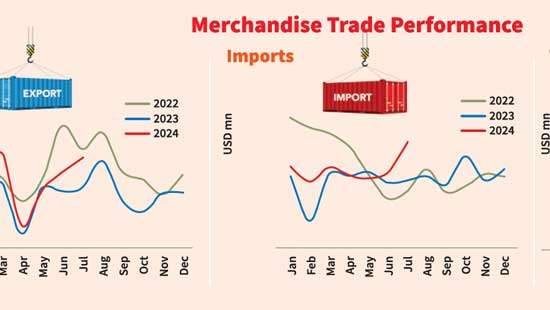Reply To:
Name - Reply Comment


Merchandise trade deficit, what Sri Lanka spent for its imports over its exports, expanded in July and so was for the cumulative seven months as imports gained pace with the economy normalising.
Sri Lanka exported goods worth US$ 1,130 million in July, up by a robust 10.8 percent from the same month last year with the contribution coming from all major categories of exports such as industrial led by textiles and garments and agriculture from spices, tea and coconut related products.
Meanwhile, imports accelerated, rising in July by 25 percent to US$ 1,734 million from a year ago as all three major categories – intermediate, consumer and investment goods picked up with economy gaining steam.
This led to a notable expansion in the trade deficit in July to US$ 604 million, from US$ 367 million in the same month last year. For the seven months, the deficit widened to US$ 3,143.8 million from US$ 2,656.6 million in the same period in 2023.
But this shouldn’t cause alarm as this amply reflects that the economy has nearly normalised with the exception of the imports of vehicles which still remains under suspension for the fifth year running.
The fuel imports too remain moderate with the country expending US$ 336.9 million for both refined and crude oil, down 11.6 percent from a year ago.
For the seven months through July, the country spent US$ 2,546.1 million for fuel, still 6.9 percent below what it spent in the same period in 2023.
The relatively benign oil prices in the global markets largely contribute to the relatively low oil bill for the country which is again a reason for lower prices at home. And so were the modest global commodities prices.
Sri Lanka’s inflation as measured by the Colombo Consumer Price Index slowed significantly to 0.5 percent in the twelve months through August 2024, from 2.4 percent through July as the country did pass the benefit of lower oil prices and the rupee strength in recent times to the masses. On a positive note, Sri Lanka earned US$ 444.6 million from garments and textiles in July, marking a 3.7 percent increase from a year ago. This narrowed the seven months earnings decline in such earnings to 1.3 percent to US$ 2,852.7 million. Tea exports rose by 8.2 percent to US$ 124.7 million while the coconut and spices exports staged higher growths of 23.3 percent and 63.3 percent to US$ 38.4 million and US$ 60.8 million respectively.
In imports, again on a positive sign, the consumer imports have risen by 21.2 percent to US$ 323.3 million in July with food and beverage imports contributing US$ 177.7 million, which was up 10.8 percent. Dairy imports slumped 53.1 percent to US$ 19.3 million while sugar and confectionery imports surged 212 percent to US$ 46.4 million.
Consumer discretionary such as home appliances, clothing, telecommunication devices and household and furniture items rose by between double and triple digits, signalling pick up in consumer demand.